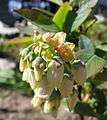Vaccinium corymbosum
| Northern highbush blueberry | |
|---|---|
.jpg) | |
| Scientific classification | |
| Kingdom: | Plantae |
| (unranked): | Angiosperms |
| (unranked): | Eudicots |
| (unranked): | Asterids |
| Order: | Ericales |
| Family: | Ericaceae |
| Genus: | Vaccinium |
| Species: | V. corymbosum |
| Binomial name | |
| Vaccinium corymbosum L. 1753 | |
| Synonyms[1] | |
| |
| Part of a series on |
| American cuisine |
|---|
|
Regional cuisines
|
|
Ingredients and foods |
|
Ethnic and cultural |
|
Holidays and festivals |
|
Vaccinium corymbosum, the northern highbush blueberry, is a North American species of blueberry which has become a food crop of significant economic importance. It is native to eastern Canada and the eastern and southern United States, from Ontario east to Nova Scotia and south as far as Florida and eastern Texas. It is also naturalized in other places: Europe, Japan, New Zealand, the Pacific Northwest of North America, etc.[2][3][4][5] Other common names include blue huckleberry, tall huckleberry, swamp huckleberry, high blueberry, and swamp blueberry.[6]
Description
Vaccinium corymbosum is a deciduous shrub growing to 6–12 feet (1.8–3.7 m) tall and wide. It is often found in dense thickets. The dark glossy green leaves are elliptical and up to 5 centimetres (2.0 in) long. In autumn, the leaves turn to a brilliant red, orange, yellow, and/or purple.[4][7]
The flowers are long bell- or urn-shaped white to very light pink, 0.33 inches (8.4 mm) long.[4][7]
The fruit is a 0.25–0.5 inches (6.4–12.7 mm) diameter blue-black berry.[4] This plant is found in wooded or open areas with moist acidic soils.[7][8]
The species is tetraploid and does not self-pollinate.[9] Most cultivars have a chilling requirement greater than 800 hours.
History
Many wild species of Vaccinium are thought to have been cultivated by Native Americans for thousands of years, with intentional crop burnings in northeastern areas being apparent from archeological evidence.[9] V. corymbosum, being one of the species likely used by these peoples, was later studied and domesticated in 1908 by Frederick Vernon Coville.
Uses
In natural habitats it is a food source for native and migrating birds, bears, and small mammals.
The berries were collected and used in Native American cuisine in areas where Vaccinium corymbosum grew as a native plant.[10]
Cultivation
Vaccinium corymbosum is the most common commercially grown blueberry in present-day North America.
It is also cultivated as an ornamental plant for home and wildlife gardens and natural landscaping projects.[8][11] The pH must be very acidic (4.5 to 5.5).[4]
Cultivars
Some common cultivar varieties are listed here, grouped by approximate start of the harvest season:[12]
|
|
|
The cultivars Duke[13] and Spartan[14] have gained the Royal Horticultural Society's Award of Garden Merit.
Southern highbush blueberry
Some named Southern highbush blueberry are hybridized forms derived from crosses between V. corymbosum and Vaccinium darrowii, a native of the Southeastern U.S. These hybrids and other cultivars of V. darrowii (Southern highbush blueberry) have been developed for cultivation in warm southern and western regions of North America.[15][16]
Gallery
 Mature shrub.
Mature shrub. Young shrub with fruit.
Young shrub with fruit. Foliage
Foliage Flowers
Flowers Berries, ripe and unripe.
Berries, ripe and unripe. Berry closeup
Berry closeup
See also
References
- ↑ The Plant List, Vaccinium corymbosum L.
- ↑ Biota of North America Program 2014 county distribution map
- ↑ Taxonomic account from Integrated Taxonomic Information System (ITIS) — for Vaccinium corymbosum (highbush blueberry)
- 1 2 3 4 5 Vaccinium corymbosum. accessed 3.23.2013
- ↑ GRIN . accessed 3.23.2013
- ↑ Gough, Robert Edward (1994). The highbush blueberry and its management. Psychology Press. p. 3. ISBN 978-1-56022-021-3. Retrieved 2011-04-29.
- 1 2 3 Flora of North America, Vaccinium corymbosum Linnaeus, 1753. High-bush blueberry, bleuet en corymbe
- 1 2 Missouri Botanical Garden: Kemper Center for Home Gardening — Vaccinium corymbosum . accessed 3.23.2013
- 1 2 Retamales, Jorge B.; Hancock, James F. (2012). Blueberries: Volume 21 of Crop production science in horticulture (1st ed.). Cambridge, MA: Centre for Agriculture and Bioscience International (CABI). pp. 2 & 39–42. ISBN 9781845938260.
- ↑ University of Michigan at Dearborn — Native American Ethnobotany of Vaccinium corymbosum . accessed 9.9.2015
- ↑ Hort.uconn.edu: Vaccinium corymbosum; Landscape use section . accessed 3.23.2013
- ↑ Hort.uconn.edu: Vaccinium corymbosum; Cultivars/varieties section . accessed 3.23.2013
- ↑ "RHS Plant Selector - Vaccinium corymbosum 'Duke'". Retrieved 16 July 2013.
- ↑ "RHS Plant Selector - Vaccinium corymbosum 'Spartan'". Retrieved 16 July 2013.
- ↑ eXtension: Southern Highbush Blueberry Varieties
- ↑ Four Winds Growers: Care of southern highbush blueberries
External links
- United States Department of Agriculture Plants Profile for Vaccinium corymbosum (highbush blueberry)
- Species account and photographs from Lady Bird Johnson Wildflower Center Native Plant Information Network (NPIN)
- Germplasm Resources Information Network—GRIN: Vaccinium corymbosum
- Gardenersite.com: Vaccinium corymbosum cultivar 'Reka'
| Wikimedia Commons has media related to Vaccinium corymbosum. |